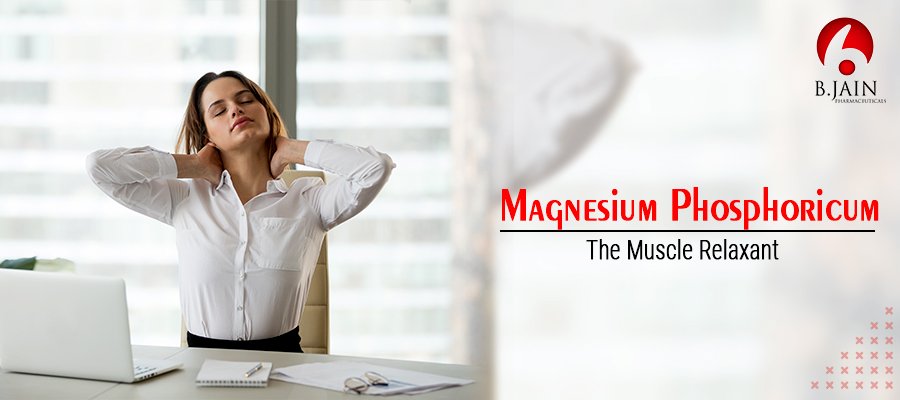Magnesium Phosphoricum or the Phosphate of Magnesia is a tissue salt and is one of Schuessler’s 12 Tissue remedies. It has great anti-spasmodic properties and hence is well known for its action on cramping muscles, radiating pains, neuralgic pains, and mental exertion.
In this article, we try to explain its action by means of understanding its chemical makeup and why it does what it does, so brilliantly.
Magnesium Phosphoricum exists as a white crystalline powder that is slightly soluble in water. This is also why it is available as a trituration up to 6X potency. 6X trituration can be converted to liquid 8x which is the lowest available liquid potency. As per The Homoeopathic Pharmacopoeia of the United States-It exists as a white, inodorous, crystalline powder that is practically insoluble in alcohol and very slightly soluble in water.
Benefits of this salt include:
- It being a rich source of both magnesium and phosphorus, which makes it a part of many mineral supplements.
- It helps with Vitamin E deficiency
- In order for Vitamin D to be effective, adequate Magnesium levels are required in the body. In fact, without adequate levels of Magnesium, excessive Vitamin D supplements can be harmful by causing vascular calcification since the Calcium and phosphorus levels rise despite the person remaining Vitamin D deficient due to absence of enough magnesium.
- It can be used in infant formula
- It is used as a nutrient, pH buffer and stabilizer.
- It is widely used in the relaxation of muscles.
- A regular intake of this salt helps maintain good bone health and muscle movements. By improving bone formation, it helps prevent osteoporosis.
- It also helps with cardiovascular health and nervous system regulation. This is so because even the cardiac muscles require magnesium to function well.
- This salt helps with anxiety and other mental stressors since it regulates the activity of the hypothalamic-pituitary-adrenal axis.
- It helps prevent diabetes, in fact doctors recommend it to diabetic patients since it helps control glucose levels and prevent insulin resistance. Patients with excessive craving for sweets are advised to consume almonds due to their high magnesium content for the same reason.
- It also helps improve the energy levels of the body and prevent migraines by relaxing muscles and blood vessels.
Let us now understand the 2 main components of this salt from the Homoeopathic angle:
1. Magnesium:
The main theme of the Magnesium group of remedies is their need for support. They have a high desire for security and hence have an unexplained anxiety. Magnesium patient can claim to have no stress and troubles due to being unaware of their own internal feelings. This emotional unawareness arises from having lived a deprived childhood and being forced to remain distant from their internal emotions. It can arise from neglect from an upbringing in an emotionally void environment at home which can also give rise to feelings of being forsaken. There is a history of emotional repression and a need to pacify which makes them run away from aggressive or confrontational situations. The patient is usually chilly and is better by warmth.
2. Phosphorus:
Oversensitivity is a prominent trait in Phosphorus salts, which comes from its character to combust so easily even at room temperature. It is highly volatile when isolated and the same is reflected in its temperament. Its name is derived from the Latin word “Lucifer” meaning Light bearer, and is also related to the planet Venus by being referred to as the “Morning Star”. It is an essential part of life, being a component of DNA itself and was first discovered in urine by German Alchemist Hennig Brand in 1669. Its uses span from a range of being a food additive, preservative, fertilizer, an important component in steel production, for making matches, etc.
Homoeopathic Uses of the Salt Magnesium Phosphoricum include:
- It is very useful for neuralgic pains that are relieved by warmth.
- Helps with severe neuralgic ear pains and pain in supraorbital region of the eyes.
- Helps with teething troubles in children.
- Pain in abdomen that forces one to bend double and is accompanied by belching and eructation but without relief.
- Helps with menstrual colic and membranous dysmenorrhea.
- Also helps with spasmodic cough and angina.
- Ailments are worse on right side and are better by warmth, bending double, pressure and by friction.
Trituration in the tablet section follows the detailed and accurate Hahnemanian method at B Jain Pharmaceuticals, according to which, one part of medicine is mixed with 9 parts of lactose and then triturated in 3 sets of 20 minutes each and strict vigilance over the Raw Materials being used for each remedy. The first samples of every batch are tested for friability, DT and weight variation. Original Mortar and Pestle are used for this process to ensure that Dr Hahnemann’s principles are followed. Quality is provided in each batch due to the experience of the brand and their commitment towards the community. Tablets made at B Jain Pharmaceuticals are known for their fastest dissolution time and impeccable quality. Magnesium Phosphoricum is available in the form of Biochemic Tablets, as a part of Biocombinations, in Dilution form, as LM Potency as well as in Speciality products such as Omeo Dentition Tablets, Omeo Broncholite Syrup, Omeo She Drops, etc. For more details you can visit www.bjainpharma.com

Dr. Priyanka Motwani
Dr. Priyanka Motwani has completed her BHMS from the prestigious Nehru Homeopathic Medical College and Hospital, Delhi and holds a Post Graduate Program in Lean Six Sigma from Isenberg School of Management, The University of Massachusetts, Amherst. She is currently the R&D Head at BJain Pharmaceuticals and has a zeal to learn more and more each day.


